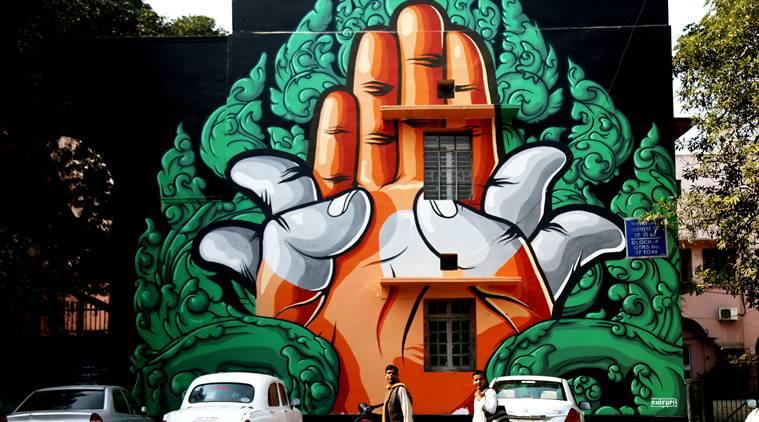Art goes public in the capital
"A lot of artists are turning into open gallery like graffiti and wall art as a medium, to display their creativity in open spaces and make it visible to a far larger audience than they would ever get in a gallery," Yogesh Saini, Founder, Delhi Street Art (DSA) said.
By: IANS | New Delhi | Published: July 6, 2017 8:27:45 pm

The padma mudra as part of the 22 Graffiti art paintings inbstallations at the Lodhi Colony for the Indian Street Art Festival in New Delhi. (Source: Express Photo)
Suddenly, dull residential areas in the centre of the capital, with their typical box-shaped, whitewashed government housing, have come to life. The area around Lodhi Road, which has one of the capital’s oldest markets, has now come to be known as perhaps the country’s first public-art area. The once poster-defaced walls of the colony are on Thursday painted with graffiti and wall art as muralists have found a new canvas, taking art to open spaces for everyone, instead of restricting it within the four walls of a gallery for only the cognoscenti.
“A lot of artists are turning into open gallery like graffiti and wall art as a medium, to display their creativity in open spaces and make it visible to a far larger audience than they would ever get in a gallery,” Yogesh Saini, Founder, Delhi Street Art (DSA), told IANS. Not just Lodhi Colony, but places like Shahpur Jat, Shankar Market, the Inland Container Depot in Okhla, city flyovers and metro stations too have been turned into giant canvases for paintings by artists.
“Why limit art to inside a gallery when murals can connect many at a time? So we decided to make art more democratic, more accessible and more understanding. And murals are a great way to promote a dialogue between a city and its inhabitants,” said Akshat Nauriyal, co-founder, St+Art Foundation, which promotes and organises mural paintings in Delhi and other parts of the country.
While younger artists are bringing in Western-style graffiti to the streets, the area is also becoming a bigger and better platform for those artists who are trying to revive the folk and tribal art forms. Rajasthan-based artist Mahendra Pawar, who ornates the walls with frescoes and miniature paintings of the Shekhawati region, is one such.
“These kinds of paintings are usually visible in the forts and havelis of Rajasthan. But, unfortunately, the havelis are being pulled down, which restricts the scope for mural artists to grow. But here, I can show it to a bigger crowd; I am trying to preserve a tradition that is fading away,” Pawar said.
Another mural artist, Rakesh Kumar Memrot, who has been in the profession for over a decade, took Gond art — a traditional tribal art form from Madhya Pradesh — as his inspiration for work in Lodhi Colony. “Wall art has been in India since long, especially in the rural areas where one paints in houses. And for artists belonging to the middle class who cannot afford galleries, painting murals in urban spaces is a big opportunity to showcase talent,” Memrot said.
On the other hand, there are artists like Kajal Singh, aka Dizy, who do not believe in following any particular pattern. “Most of my works are abstract as I just go with the flow. Yes, sometimes I do select a theme, but I try to keep it very much contemporary so that the onlookers can understand the meaning,” Singh said.
For mural artists, the rise in the street art movement in the national capital has been an encouraging opportunity as many of them have started considering wall art as a serious profession. “There has been a considerate increase in mural and graffiti artists in the past few months. Not just DSA or St+Art but many other communities have also come up. Even government bodies like NDMC and CPWD have started requesting artists to come up with more wall art,” mural artist Anpu Varkey said.
St+Art Foundation’s Nauriyal pointed out that at places like Shahpur Jat, Shankar Market and Lodhi Colony, pedestrians often stand and gaze at the walls and even take selfies. “We have even turned garbage cans into canvases and people have started using them more instead of dumping the waste on roads. With art on the walls there remain fewer chances of pamphlets. And even people hesitate to pee on the walls,” DSA’s Saini added. Compared to the West, the trend is new in India and gradually emerging. However, all the artists are hopeful that this new phenomenon of wall art will soon match international levels.






















No hay comentarios:
Publicar un comentario